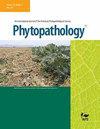植物病害重点拓展。1:聚焦扩展的恒定速率。
IF 3.1
2区 农林科学
Q2 PLANT SCIENCES
引用次数: 0
摘要
根据理论,作物的疾病焦点以径向的速率逐渐接近一个常数。这个值可以通过时间核、接触分布和总再现来计算。时间核描述接种物随时间的产生,接触分布描述接种物的分散。总繁殖是指单个感染者在仅由受感染者组成的群体中产生的受害个体的总数。给出了定义和数学证据。本文章由计算机程序翻译,如有差异,请以英文原文为准。
Focus Expansion in Plant Disease. I: The Constant Rate of Focus Expansion.
According to theory, a focus of disease in a crop expands radially at a rate that asymptotically approaches a constant value. This value can be calculated from the time kernel, contact distribution, and gross reproduction. Time kernel describes the inoculum production through time and contact distribution describes inoculum dispersal. Gross reproduction is the total number of victimized individuals produced by a single infectant placed in a population consisting of suscepts only. Definitions and mathematical evidence are given.
求助全文
通过发布文献求助,成功后即可免费获取论文全文。
去求助
来源期刊

Phytopathology
生物-植物科学
CiteScore
5.90
自引率
9.40%
发文量
505
审稿时长
4-8 weeks
期刊介绍:
Phytopathology publishes articles on fundamental research that advances understanding of the nature of plant diseases, the agents that cause them, their spread, the losses they cause, and measures that can be used to control them. Phytopathology considers manuscripts covering all aspects of plant diseases including bacteriology, host-parasite biochemistry and cell biology, biological control, disease control and pest management, description of new pathogen species description of new pathogen species, ecology and population biology, epidemiology, disease etiology, host genetics and resistance, mycology, nematology, plant stress and abiotic disorders, postharvest pathology and mycotoxins, and virology. Papers dealing mainly with taxonomy, such as descriptions of new plant pathogen taxa are acceptable if they include plant disease research results such as pathogenicity, host range, etc. Taxonomic papers that focus on classification, identification, and nomenclature below the subspecies level may also be submitted to Phytopathology.
 求助内容:
求助内容: 应助结果提醒方式:
应助结果提醒方式:


